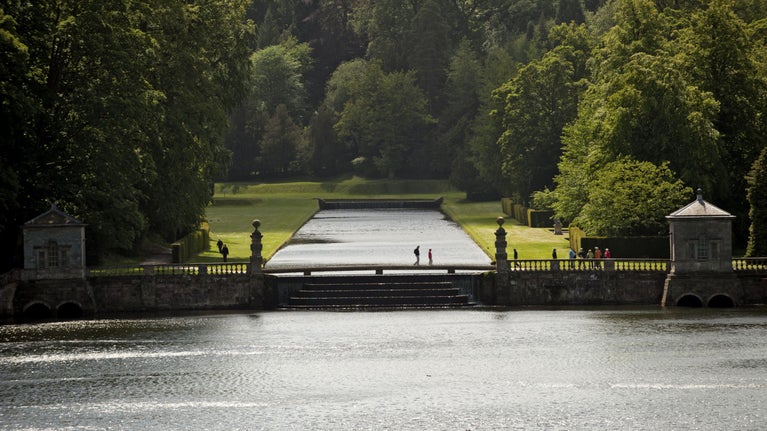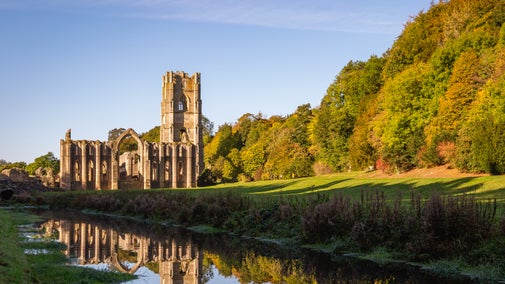World Heritage Site Fountains Abbey and Studley Royal

Discover how in 1986 Studley Royal Park, including the ruins of Fountains Abbey, became one of the first places in the UK to be named a UNESCO World Heritage Site. Find out what it takes to be listed alongside such sites as Stonehenge and Versailles, and the work involved in preserving Fountains Abbey and Studley Royal for generations to come.
What is a World Heritage Site?
The World Heritage Site list is chosen by the United Nations Educational, Scientific and Cultural Organisation (UNESCO). This list is made up of sites across the world which have great cultural and/or natural value and need to be treasured and maintained for future generations.
To become a World Heritage Site you must be able to show 'outstanding universal value' and be able to meet one of 10 criteria set out by UNESCO.
How does it happen?
It's a gruelling process to become a World Heritage Site. Firstly, after lots of hard work, the site makes it onto a 'tentative list of future nominations'. Then the UNESCO World Heritage Committee decides whether the place will make it onto the list that also includes Machu Picchu, the Great Wall of China, the natural wonder of Giant's Causway and the pyramid fields from Giza to Dashur.
Why is Fountains Abbey and Studley Royal a World Heritage Site?
Recognised in 1986 as a ‘feat of human creative genius’, Fountains Abbey and Studley Royal met two of the criteria that UNESCO set out:
'Criterion (i): to represent a masterpiece of human creative genius'
Studley Royal Park, including the ruins of Fountains Abbey, owes its originality and striking beauty to the fact that a humanised landscape was created around the largest medieval ruins in the United Kingdom. The use of these features, combined with the planning of the water garden itself, is a true masterpiece of human creative genius.
'Criterion (iv): be an outstanding example of a type of building or architectural ensemble which illustrates a significant stage in history.'
Studley Royal Park combines the ruins of Fountains Abbey, the Jacobean Fountains Hall and Burges’s miniature neo-Gothic masterpiece St Mary’s Church with the water gardens and deer park into one harmonious whole. Together they illustrate the power of medieval monasticism and the taste and wealth of the European upper classes in the 18th century.

It's not all about the abbey
Many visitors assume that it’s Fountains Abbey which gives the estate its World Heritage status. In fact, it’s because of the ‘harmonious whole of buildings, gardens, and landscapes…which represents over 800 years of human ambition, design and achievement'. Studley Royal water garden is an essential element of this harmonious whole.
A tale of two parts
There are two distinct parts to the Fountains Abbey and Studley Royal estate, as the name suggests: Studley Royal water garden and the ruins of Fountains Abbey. The two parts, while so different, merge together to create one awe-inspiring whole.
The garden vision
The water garden at Studley Royal is one of the few great 18th-century gardens to have survived well in its original form. It's the creation of John Aislabie and later his son, William. They both had astounding vision for how they wanted this garden to look, working with the landscape rather than changing it.
Their design ingeniously channels the winding waters of the River Skell past the abbey ruins and into moon-shaped ponds and mirrored lakes, framed by formal bosquet hedges and laurel banks. They pushed the boundaries of what was considered to be a garden and heavily influenced the typical 'English' garden style.

Beyond the abbey and water garden
On the west side of the abbey lies the transitional Elizabethan/Jacobean Fountains Hall – partially built using stone from the abbey – and Fountains Mill. Situated in the medieval deer park is St Mary's church. Designed by William Burges in 1871, it’s often thought to be one of his greatest pieces of work.
What does it take to look after a World Heritage Site?
It’s a big responsibility to look after the site and to preserve it for the generations to come. But as a conservation charity, this is what we do best. Learn more about our whole 2023-2029 World Heritage Site management plan:
World Heritage Site Management Plan 2023–2029
World Heritage Site Management Plan Summary 2023–2029
World Heritage Site Management Plan maps
World Heritage Site Management Plan appendices
Buffer zone proposal submission to UNESCO
World Heritage Site Progress Report 2025
If you have any questions or would just like to find out a little more about this process please do email us at fountainsabbey@nationaltrust.org.uk
Allow video to play? This page contains content that is published to YouTube.
We ask for your permission before anything is loaded, as this content may introduce additional cookies. You may want to read the Google YouTube terms of service and privacy policy before accepting.
Fountains Abbey and Studley Royal: a World Heritage Site
Take a look at this World Heritage Site from an extraordinary new perspective.
You might also be interested in

Garden and abbey tour
Join one of our volunteer tour guides to see the abbey as the Georgians once did; incorporated into the dramatic designed landscape.

Past conservation projects at Fountains Abbey and Studley Royal
Dive into some of the past conservation projects at Fountains Abbey and Studley Royal, Yorkshire, aimed at restoring the vision of John and William Aislabie.

Skell Valley Project
Keep up with the latest updates as the Skell Valley Project takes place, looking to create a sustainable future for the Skell Valley in North Yorkshire.

History of Fountains Abbey and Studley Royal
Step back into a dramatic past and imagine what life would have been like for the monks lived here, and learn how Fountains Abbey and Studley Royal became one.